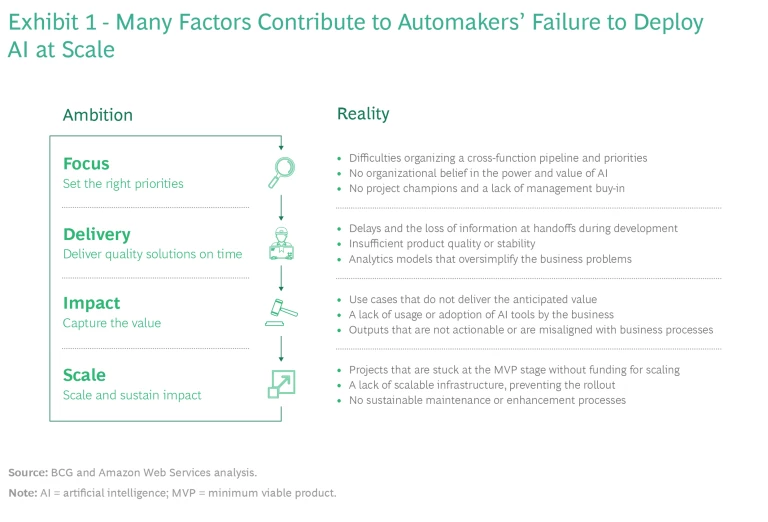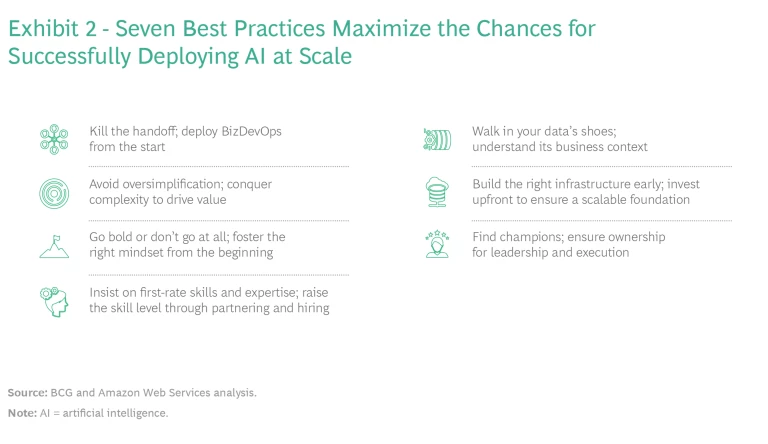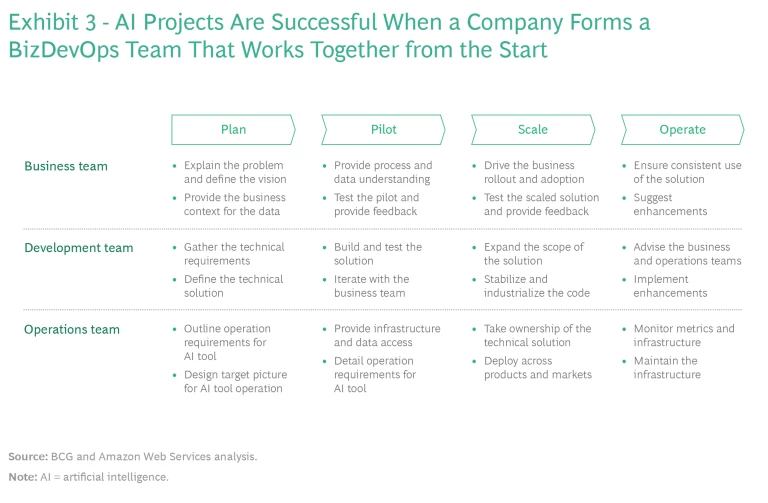OEMs have harnessed AI’s power under the hood. Now they must apply it in sales. Seven best practices help automakers scale AI across the organization.
Automakers have been investing in artificial intelligence (AI) to develop autonomous driving capabilities and advanced driver-assistance systems. But many are only just beginning to apply AI in sales and marketing, where the investment needs are lower and the payback is significantly faster.
We see abundant opportunities for automotive OEMs to deploy AI in sales and marketing to improve financial performance. AI can guide automakers on how to target prices and rebates, improving profitability by as much as 5%. It can optimize the pricing of aftermarket parts, yielding up to 5% top-line growth. AI can create better micromarket intelligence, producing up to 3% sales growth. And it can predict inventory needs and optimal vehicle configurations, reducing the number of days an unsold vehicle sits on a dealer’s lot, often by as much as 30%. According to a recent BCG report, the top use cases together can generate 10% to 25% bottom-line growth. For an OEM with $100 billion in sales, this can mean more than $1 billion in incremental operating income.
Auto companies have chased these gains by piloting various use cases. However, many have frequently failed to scale the use cases and, consequently, haven’t obtained significant value from their investments. In their quest for exponential or hockey stick growth, OEMs often fail to reach the steep section of the curve.
A variety of challenges contributes to the fail-to-scale pattern. (See Exhibit 1.) For example, automotive companies typically approach AI projects in a disjointed manner. They tap one team to devise the project, another to build a proof of concept (PoC), a third to launch a minimum viable product (MVP), and a fourth to scale the venture. Many AI solutions also fail because their underlying algorithms oversimplify the business problems they are intended to solve, rather than conquer the problems’ complexities.
As automakers stretch to market new advanced technologies, deploying AI applications at scale in sales and marketing will be essential to remain competitive. Companies must get this right. These applications are critical tools for creating smarter and more profitable sales and marketing processes.
The Ingredients for Successfully Deploying AI
What is needed to realize the full benefit of AI in sales and marketing? A recent study by BCG GAMMA, the BCG Henderson Institute, and the MIT Sloan Management Review finds that the ability to engage in organizational learning with AI gives companies a 73% chance of reaping the financial benefits of their AI investments. But before companies can engage in learning with AI, they must scale AI applications, which is a major challenge for auto companies. A collaboration between BCG and Amazon Web Services (AWS) has identified seven best practices that maximize the chances of deploying AI solutions successfully across a global organization. (See Exhibit 2.)
Kill the handoff; deploy BizDevOps from the start. Companies typically fail to build a team in a format that breaks down boundaries and encourages cooperation. Frequently, a development project starts with the business team asking the development team to build an AI solution for an identified business problem. The development team then creates a PoC and an MVP in a vacuum without sufficient input from the business team. The development team also doesn’t properly plan for scaling and operating the solution. Then the operations team takes over and finds that it lacks a comprehensive understanding of the decisions made because it was not part of the development process. Furthermore, information is lost in the handoff, creating issues with the AI tool’s operations and stability. Each group starts blaming the other for the problems, and the solution is abandoned.
The success rate of AI projects will increase if companies clarify the responsibilities of the business, development, and operations teams from the start and the leadership of all three participates from the outset. (See Exhibit 3.) When done right, a scrum team process, where all subteams are represented in daily and weekly progress meetings, can help. This approach keeps the development team in close alignment with the business team and helps the operations team understand the choices made during the creation of the solution. It also avoids the handoffs that lead to critical gaps in successive teams’ knowledge. And this approach emphasizes creating a stable team and preventing the problems that arise when companies onboard specific skill sets at various points in the process.
Walk in your data’s shoes; understand its business context. The data that forms the basis of any AI solution is likely to be both imperfect and not intuitive. For example, the quality of the data may be subpar because of poor data-collection practices. There also may be important patterns in the data because of the peculiarities of the business process that generated it.
Developers should work closely with the business experts who were involved in generating the data.
Unfortunately, when AI solutions are developed, insufficient knowledge is often exchanged between the business and development teams. Instead of speaking with the business team, the development team builds only a superficial understanding of the variables through exploratory analyses before feeding the data into the model. Then later in the process, the developers learn that a change to a system or process affected the quality and logic of the data, which is causing the AI model to generate incorrect or inaccurate results.
Companies can avoid this outcome by directing the developers to work closely with the business experts who were involved in generating the data. Their guidance must be comprehensive and include the data history, the behavioral part of data entry, the conventions, past changes, and upcoming planned changes. All of this must happen before the development of the solution starts. This aspect of the AI use case journey is particularly tricky to scale, as it must be repeated for the data from every market and product. However, the correct process for understanding the data can be standardized and tightly integrated in the development process, making it easier to execute with every iteration.
Avoid oversimplification; conquer complexity to drive value. While it seems basic, a solution must solve the problem for which it is intended. Many AI solutions fail because their algorithms oversimplify the business problem rather than conquer its complexity. It is critical to have a complete list of all the business requirements for an AI solution, including market- and product-specific requirements, and to decide how to address them by consulting with the appropriate experts in the company.
Businesses should require the development team to understand product, customer, and market differences.
While an AI solution’s key components (such as the infrastructure setup and data pipelines) often can be reused across markets and products, companies run into trouble when they apply a one-size-fits-all standard analytics model across products and markets. The AI solution then fails to address each segment’s unique characteristics and requirements, reducing the quality and relevance of the output. When the operations team takes over, it discovers that the outputs of the AI solution are not compatible with relevant processes or user requirements, and the team is forced to abandon the project.
Businesses can avoid this outcome by requiring the development team to understand the product, customer, and market differences that would interfere with a standard solution. Learning about these differences requires working closely with the product and market teams. The development team also needs to serve as its own devil’s advocate to discover why the AI application cannot be a one-size-fits-all solution.
Build the right infrastructure early; invest upfront to ensure a scalable foundation. Putting in place the proper cloud infrastructure when developing the PoC increases the chances of ultimately achieving scale. However, companies often fail to appreciate the impact of implementing state-of-the-art cloud infrastructure and, therefore, do not prioritize it.
AI solutions in automotive sales and marketing require cloud-based approaches because they rely on dozens of inputs from many different functions within the organization, including sales, finance, production, and supply chain. Bringing these data sources together in a safe and scalable way is hardly possible in an offline environment, especially considering the anonymization techniques that are required for compliance with data privacy laws and regulations governing competition.
Developing an AI solution using an offline approach also makes it difficult to update the data and keep the information current. It hinders the team from applying relevant lessons easily across products and markets. And ultimately, significant additional work is required to adapt the offline code for the cloud.
A better strategy is to set up a dedicated cloud data platform, or data lake, at the start of the project. It is worth taking the time to develop a plan for integrating all required data from various source systems into the data lake, minimizing the manual effort that’s required during the operation of the solution.
Using modern cloud infrastructure also enables AI use cases in other ways. It allows the development team to implement stringent data security and data anonymization requirements—a prerequisite for combining data from various parts of the organization. It provides the ability to scale almost infinitely because computing power can be adjusted on the fly and data storage is unlimited. And it enables the seamless transfer or reuse of relevant parts of the solution across products and markets.
Go bold or don’t go at all; foster the right mindset from the beginning. When it comes to developing AI solutions, companies must be all in. The project team and sponsors need to adopt an opt-out mindset rather than an opt-in attitude. They should approach it with a firm conviction that the AI use case will work. There will still be quality gates and go-no-go decision points, but they should only stop the project if there are strong indications against the solution’s value.
Without a growth mindset and firm intent from the start to scale an AI solution, the initial funding is typically approved only for the MVP stage. To scale the solution, the development team will need a new budget. While waiting for budget approval—which can take six months or more—the effort often loses momentum as the business and development teams shift to other projects. When the new budget is approved, the company sets up a new team with people who didn’t develop the MVP and who end up rebuilding significant parts of the solution.
Companies can avoid these problems by adopting an aggressive and comprehensive approach that signals that the solution is expected to succeed. While pitching the project to sponsors in the organization, the advocates must emphasize the time and cost that’s required to build an MVP. They should also highlight the potential value and cost of scaling the solution. That will avoid sticker shock and delays later as a result of new budget requests in the middle of the development journey.
Companies need to choose their AI project champions carefully and support them.
Find champions; ensure ownership for leadership and execution. Launching an AI use case requires two champions who are passionate about the project’s potential: One must provide leadership and guide the project through management reviews and budget changes. The other must combine the qualities of an inventor and entrepreneur and fill the role of the execution partner and product owner.
It is highly likely that companies will face pressure to change project champions—and likely more than once—during the development and scaling of the solution because of delays, shifting internal priorities, and role changes. That’s why companies need to choose their AI project champions carefully and support them. Companies need to choose people who believe so strongly in the solution’s value that they will want to stay attached to the project and prioritize it—and then companies need to help those people make it happen. This will add continuity and be a crucial ingredient in helping the project succeed. Time and time again, we have found that the best and most successfully scaled solutions had outstanding, tireless leaders who drove them forward.
Insist on first-rate skills and expertise; raise the skill level through partnering and hiring. Companies launching AI projects need to select internal people and external partners with the best skill sets and knowledge for their respective roles on the project. All involved parties must have clearly defined and complementary roles and a long-term commitment to ensure the project’s success.
Too often, companies engage internal people and external partners who have overlapping skills and responsibilities, which inevitably leads to confusion and team friction. This approach also has the potential to generate harmful power games and politics, both of which undermine effective collaboration. Rather, companies should create an integrated team that works together effectively.
Building AI Solutions for the Future
For much of the past century, innovation in auto sales and marketing has centered on incremental process improvements. OEM and third-party websites today help consumers research vehicles, and many portals refer leads to automakers. But except for their use of digital marketing, many OEMs largely sell and market vehicles like they have done for decades.
AI solutions for sales and marketing are different than previous process improvements because they are an entirely new lever for value creation. Automakers’ lack of experience with this new lever leads to unscalable projects that fail to deliver the anticipated value.
Companies will get the best return from their AI investments when they take a holistic development approach. Individually, none of the seven best practices will ensure success. However, our experience has shown that paying attention to these lessons in sum can dramatically increase the chances of success.
Automakers that fail to craft a successful approach for developing and deploying AI solutions to optimize sales and marketing will find themselves at a disadvantage in an increasingly competitive market. New, innovative entrants and incumbent rivals will harness the power of AI to drive sales and increase profitability, leaving others behind.









